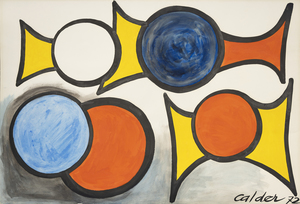ALEXANDER CALDER: SHAPING A PRIMARY UNIVERSE
“Why must art be static?” -Alexander Calder
Heather James provides a rare look into the history-making and joyous art of Alexander Calder. The exhibition explores three different aspects of Calder’s oeuvre – his groundbreaking sculptures, his vibrant oil paintings, and his dynamic gouaches on paper. Few exhibitions have covered all three of these modalities. Our show will look at the unifying links connecting these disparate mediums – the search of dynamism through primary shapes and colors – creating his own unique universe that speaks to everyone.
ARTWORK
Alexander Calder: Shaping a Primary Universe
“Just as one can compose colors, or forms, so one can compose motions.” -Alexander Calder
THE SCULPTURES
The exhibition opens with Calder’s sculptures. Calder first began experimenting with sculpture by translating the idea of line drawings into wire sculptures, thus creating three-dimensional “drawings”. In 1931, he developed his groundbreaking kinetic sculptures which Marcel Duchamp termed “mobiles”. Rather than using any mechanized component, these kinetic sculptures relied on air currents to create movement. Far from a static object, these mobiles continually change shape, challenging our perception of space and time and the relationship between form and color.
Cantilever is an intimate sculpture featuring many of his hallmarks – primary colors along with black and white and simple organic shapes. As hinted in the title, this standing mobile tests the limits of balance, both physical and visual equilibrium, that characterizes Calder’s mobiles. The horizontality of the sculpture, the bright colors, and the organic shapes speak to joy and whimsy many people experience when viewing Calder’s works.
Prelude to the Man-Eater is a study for a sculpture that is now in the permanent collection of Museum of Modern Art in New York. That standing mobile, Man-Eater with Pennants, was commissioned by Alfred Barr, the first director of MoMA. In both pieces, the different metal components move around a central post. Maquettes and studies played a vital role in Calder’s practice as it gave him the opportunity to understand scale and balance before scaling up the piece. Often, these maquettes existed in the smaller size for decades before enlarging or simply existed at their size and never made into larger works. In Prelude, we can see Calder thinking more vertically compared to the final piece at MoMA.
The three decades that separate these two standing mobiles shows that while many elements stayed consistent within Calder’s body of work, the artist constantly experimented with how to create visually dynamic and balanced art, whether in the metal shapes, the color, or vertical versus horizontal.
Heather James is also proud to present a rare early wooden figurative sculpture by Calder. Dating from 1928, the sculpture depicts a woman with an umbrella. Despite being known for his abstract art, Calder never fully abandoned figuration, finding a way to blend the two or bouncing between them throughout his entire career.
THE PAINTINGS
By the 1940s and 50s, Calder had become so popular as a sculptor that he largely left painting behind, concentrating on creating the kinetic sculptural vocabulary that we know him for. Nevertheless, he never completely abandoned painting. The exhibition features a rare oil painting from the 1940s.
In this early painting, we can see Calder working through certain shapes that would recur throughout his career both in sculptural form and on a flat surface. Circles, ovals, and other geometries dominate the space. There is the same sense of energy and fluidity. Compare the painting to the sculptures and one can see certain motifs – arcs of red and black, the vibrant yellows. Nevertheless, we can also see differences such as the serpentine black or the curlicue cross which are not as prevalent in Calder’s most famous sculptures. Instead, we see the artist pushing what shapes could convey movement and kineticism.
THE GOUACHES
Oil was not the only medium Calder used for painting. Calder often preferred gouache as a medium for his painted work. We can think of gouache as an opaque watercolor because it contains a white pigment. Watercolor and gouache both allow the artist to paint quickly and fluidly, but both are also extremely unforgiving mediums as they dry quickly and are difficult to rework. Calder valued gouache for exactly these reasons, it dried quickly like a watercolor but delivered the bold colors he sought.
Toward the end of his life, Calder returned to the more intimate and less physically involved process of gouache painting in earnest. With a lifetime of experience as a sculptor, Calder began to transcribe his three-dimensional vocabulary onto two-dimensional paper. Gouaches became a vehicle for Calder to explore color and line, often finding the intersection of abstraction and figuration, creating art that would not be possible in three-dimensional space.
While no show could fully comprehend a lifetime of work, this exhibition gives a fuller picture of the unique vocabulary that Calder employed to explore the same themes of color, movement, and spatial enquiries from different perspectives. To see Calder in different contexts, visit our other exhibitions including First Circle: Circles in Art and Paper Cut: Unique Works on Paper.
“My whole theory about art is the disparity that exists between form, masses and movement.” -Alexander Calder















